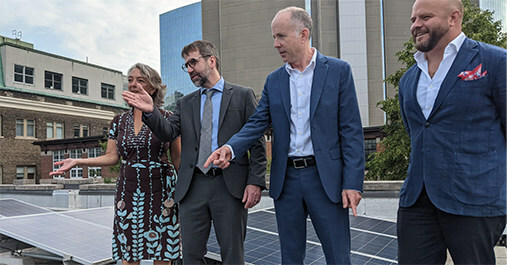
Canada leans toward more reliable electricity with draft regulations
by CM staff

The draft regulations are designed to help Canada achieve a net-zero electricity grid by 2035, in close collaboration with provinces, territories, Indigenous partners, industry, and others.

A photo of the Honourable Steven Guilbeault, Minister of Environment and Climate Change, Julie Dabrusin, Parliamentary Secretary to the Minister of Natural Resources and the Minister of Environment and Climate Change, Luke Barber, Chief Operating Officer, University of Toronto and Scott Hendershot, Senior Manager, Sustainability Office, University of Toronto, standing together on a rooftop covered in solar panels. (CNW Group/Environment and Climate Change Canada)
TORONTO — As outlined in Powering Canada Forward: Building a Clean, Affordable, and Reliable Electricity System for Every Region of Canada, published earlier this week, the government recognizes the scale required to transform Canada’s electricity sector.
The draft regulations are designed to help Canada achieve a net-zero electricity grid by 2035, in close collaboration with provinces, territories, Indigenous partners, industry, and others.
Canada’s electricity grid has over 84 percent of electricity generated from non-emitting sources like hydro, nuclear, and wind. The draft regulations will ensure the remainder of our grid is decarbonized, while meeting the needs of increasing demand for electricity. As drafted, they would cut over 340 megatonnes of greenhouse gas pollution between 2024 and 2050.
Just as the United States and G7 partners are doing, setting new rules for cleaner power will stimulate investments in renewable energy like wind and solar, smart grid and energy storage systems, and emerging technologies, such as small modular reactors and carbon capture and storage.
Canada is already seeing the benefits. Volkswagen committed earlier this year to build one of the largest battery factories in the world because of Canada’s ability to supply clean and affordable electricity. This plant alone will create 3,000 jobs.
Over $40 billion in new tax credits and other federal investments will help drive economic opportunities through the construction of new power sources and retrofitting of existing plants.
“If we are serious about tackling the climate crisis, and we want to take full advantage of the opportunities in a clean economy, then it’s time we roll up our sleeves together and build the clean electricity grid of the 21st century. A net-zero grid will serve as the basis for climate actions across the economy, like helping Canadians switch to electric transportation and heating, or the development of new and cleaner industries. The benefits, in terms of good jobs and clean air in our communities, are enormous. Our Government is committed to working closely with all provinces, territories, and partners on delivering the benefits of a clean grid in a way that ensures reliability and affordability to all Canadians.”